|
| |
|
The Rose Valley Project
by Bob Brooke
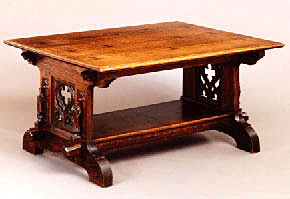 Nestled
among the stately old trees and flowering shrubs of lower Delaware
County, Pennsylvania, lies the sleepy hamlet of Rose Valley. Today,
about a thousand people live there. Driving through it, it’s not
unlike many towns west of Philadelphia that have been absorbed into
the urban sprawl. Rose Valley is quiet and peaceful—a nice place to
live. But looking at it now, it’s hard to imagine it being the
center of one of the noted Arts & Crafts utopian communities that
thrived during the early part of the 20th century. Nestled
among the stately old trees and flowering shrubs of lower Delaware
County, Pennsylvania, lies the sleepy hamlet of Rose Valley. Today,
about a thousand people live there. Driving through it, it’s not
unlike many towns west of Philadelphia that have been absorbed into
the urban sprawl. Rose Valley is quiet and peaceful—a nice place to
live. But looking at it now, it’s hard to imagine it being the
center of one of the noted Arts & Crafts utopian communities that
thrived during the early part of the 20th century.
Soon after William Penn received his charter for the Colony of
Pennsylvania, three brothers, Thomas, Robert, and Randall Vernon
received land grants from Penn to settle over 900 acres in the
present borough of Rose Valley and Nether Providence Township. The
brothers arrived in Pennsylvania in 1682 and began farming.
 Randall
Vernon built his house at the end of the 17th century. Historians
believe that Robert Vernon built the house known as the "Bishop
White House" about 1695. The name of the house comes from its use by
the family of Bishop William White during the yellow fever epidemic
of 1793 in Philadelphia. Though the Bishop visited the house, he
generally stayed in Philadelphia in 1793. Randall
Vernon built his house at the end of the 17th century. Historians
believe that Robert Vernon built the house known as the "Bishop
White House" about 1695. The name of the house comes from its use by
the family of Bishop William White during the yellow fever epidemic
of 1793 in Philadelphia. Though the Bishop visited the house, he
generally stayed in Philadelphia in 1793.
What’s left of a dam and millrace leading up to the "Old Mill," now
used as the town hall, stand along Ridley Creek near the Bishop
White House. Benninghove's snuff mill was likely built here around
1789. Between 1826 and 1850, it’s owners operated it as a paper
mill. In 1861, they reconstructed it as a textile mill which burned
down in 1885. After 1900 Will Price built a furniture mill or craft
shop on the foundations.
Hutton's mill, on Rose Valley Road by Vernon Run, began life about
1840 as a feed mill. In 1847 it became a turning mill that produced
bobbins for the nearby textile mill as well as serving as a
warehouse. Later it produced sandpaper.
The Arts & Crafts Project
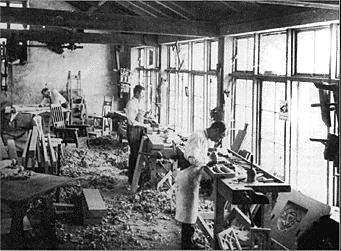 But
everything changed in 1901 when architect Will Price, along with
Horace Traubel, purchased 80 acres around the former Rose Valley
textile mill. Price and Traubel were both followers of the economic
philosophy of Henry George. Investors contributed about $25,000,
including $9,000 borrowed from nearby Swarthmore College to buy and
improve the land. Price’s intention was to give craftsmen a place to
create what they loved. To do that he formed the Rose Valley
Association in July 1901 to start an arts and crafts project, the
buildings of which form the nucleus of the Borough of Rose Valley. But
everything changed in 1901 when architect Will Price, along with
Horace Traubel, purchased 80 acres around the former Rose Valley
textile mill. Price and Traubel were both followers of the economic
philosophy of Henry George. Investors contributed about $25,000,
including $9,000 borrowed from nearby Swarthmore College to buy and
improve the land. Price’s intention was to give craftsmen a place to
create what they loved. To do that he formed the Rose Valley
Association in July 1901 to start an arts and crafts project, the
buildings of which form the nucleus of the Borough of Rose Valley.
Price renovated the buildings on the land he and Traubel purchased.
He converted the former mill workers housing into the Guest House
which housed the artists and craftsmen during the early days of the
community.
Will Price modified the Bishop White House after 1900, adding a
stone porch and red tile roof. He After 1900 Will Price built a
furniture mill or craft shop on the foundations. Price also
converted Hutton’s Mill into a meeting house and theater, but it
also suffered fire damage and was rebuilt in 1923 to house Hedgerow
Theater.
 Price
designed the houses within Rose Valley with an eye toward democracy
of dwelling—he envisioned a community in which "the tiniest cottages
may be built side by side with a more spacious neighbor." He
remodeled some homes that already existed on the land and built
others new, filling them with the work of regional artisans like
Samuel Yellin and Henry Chapman Mercer. The community members who
inhabited these homes regularly gathered for creative pursuits,
staging concerts, dances, and plays at the Guild Hall. Price
designed the houses within Rose Valley with an eye toward democracy
of dwelling—he envisioned a community in which "the tiniest cottages
may be built side by side with a more spacious neighbor." He
remodeled some homes that already existed on the land and built
others new, filling them with the work of regional artisans like
Samuel Yellin and Henry Chapman Mercer. The community members who
inhabited these homes regularly gathered for creative pursuits,
staging concerts, dances, and plays at the Guild Hall.
Price had led a discussion group, including Edward Bok and brothers
Samuel and Joseph Fels, and many in this group became investors or
residents in Rose Valley. Other early residents included Hawley
McLanahan, who became Price's architectural partner, McLanahan's
father-in-law, Charles T. Schoen, Price's employees at his
architectural firm, and his relatives, including his brother Walter,
also an architect. Feminist Anna Howard Shaw lived nearby.
Administration of the project was in the form of a town meeting,
called the "Folk Mote."
Will Price and his extended family along with Hawley
McLanahan and his family were the first members of the Rose Valley
Association. They made plans for a social center with lectures,
plays and concerts, a library, a museum, and a school for children,
who, in the words of Hawley McLanahan, would be taught “through the
hand to the brain.” They intended to convert waterpower into
electricity for use in the craft shops and the community, and to
plant trees to beautify the public and private spaces. All income
beyond the stock and fixed expenses would be devoted to the general
improvement of the property.
The
Rose Valley Association
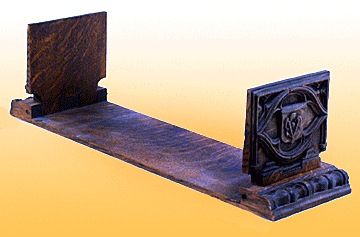 The Rose Valley Association didn’t produce arts and crafts itself,
but rather rented out working space to craftsmen and provided
housing for them which Pricey designed or renovated. Price sold the
furniture, ceramics, and bookbindings, made at the Old Mill until
about 1907, at his office in Philadelphia. Price also published a
journal, The Artsman, from 1903 to 1907. The Rose Valley Association didn’t produce arts and crafts itself,
but rather rented out working space to craftsmen and provided
housing for them which Pricey designed or renovated. Price sold the
furniture, ceramics, and bookbindings, made at the Old Mill until
about 1907, at his office in Philadelphia. Price also published a
journal, The Artsman, from 1903 to 1907.
 The
Artsman became the voice of Price’s experiment just as The Craftsman
was the voice of Gustav Stickley’s experiment. The first issue
contained cuts made from Price drawings of two chairs and a table.
These illustrations are not referred to in the text so they serve
primarily as advertisements for the furniture shop. The text,
written by the three editors, is a manifesto in which the men’s
hopes for Rose Valley were succinctly set down. Price wrote: “What
does Rose Valley hope? It hopes that some men, released from the
deadening influences of monotonous unthinking toil, may see such
possibilities in life as will make them put their shoulders to the
wheel and strive to lift society out of accustomed thought or
habit.” The
Artsman became the voice of Price’s experiment just as The Craftsman
was the voice of Gustav Stickley’s experiment. The first issue
contained cuts made from Price drawings of two chairs and a table.
These illustrations are not referred to in the text so they serve
primarily as advertisements for the furniture shop. The text,
written by the three editors, is a manifesto in which the men’s
hopes for Rose Valley were succinctly set down. Price wrote: “What
does Rose Valley hope? It hopes that some men, released from the
deadening influences of monotonous unthinking toil, may see such
possibilities in life as will make them put their shoulders to the
wheel and strive to lift society out of accustomed thought or
habit.”
In addition, he set up an art gallery in the old bobbin mill, then
called Artsman's Hall. Beginning in 1904, well-known artist Alice
Barber Stephens, who lived in the mill until Price converted a
nearby barn into a house for her called Thunderbird Lodge, managed
the gallery. Artsman's Hall also contained a theater, where the
first play, "The Carpet Bagger's Revenge," premiered on New Year's
Eve, 1904. In 1923, the Hedgerow Theater took over the building and
still regularly presents plays today.
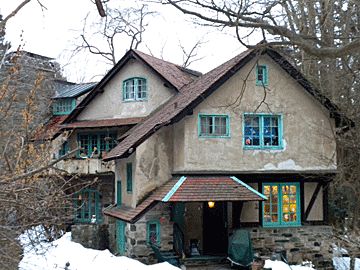 By
1910, however, craft production had declined and Rose Valley became
another commuter suburb of Philadelphia. The buildings designed or
renovated by Price during this time may be Rose Valley's major
achievement, far outlasting its crafts. By
1910, however, craft production had declined and Rose Valley became
another commuter suburb of Philadelphia. The buildings designed or
renovated by Price during this time may be Rose Valley's major
achievement, far outlasting its crafts.
After 1910 Schoen, McLanahan, and Price bought the remaining land
from the Rose Valley Association, and Price designed the "Rose
Valley Improvement Company Houses" near the old bobbin mill. These
are the most important group of houses designed, rather than
renovated, by Price in Rose Valley.
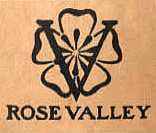 Rose
Valley was also the home to the awe-inspiring Schoenhaus. Unlike
Elbert Hubbard, founder of the Arts & Crafts Roycroft community,
Rose Valley was primarily a business venture, for Price was an early
developer, driven by the idealistic vision of a utopian community
where Arts & Crafts principles would take center stage. Rose
Valley was also the home to the awe-inspiring Schoenhaus. Unlike
Elbert Hubbard, founder of the Arts & Crafts Roycroft community,
Rose Valley was primarily a business venture, for Price was an early
developer, driven by the idealistic vision of a utopian community
where Arts & Crafts principles would take center stage.
The trademark symbol used by the furniture and pottery studios of
Rose Valley was a blooming rose overlapped with a "V" and encircled
with a belt. And though the commercial side of Rose Valley lasted
only four years, it flourished as a cultural and architectural
experiment.
<
Back
to More Back in Time
Next
Article >
|
|

|
|
FOLLOW MY WEEKLY BLOG
Antiques Q&A
JOIN MY COLLECTION
Antiques and More
on Facebook
LIKE MY FACEBOOK PAGE
The Antiques
Almanac on Facebook |
|
No antiques or collectibles
are sold on this site.
|
|
How to Recognize and
Refinish Antiques for Pleasure and Profit
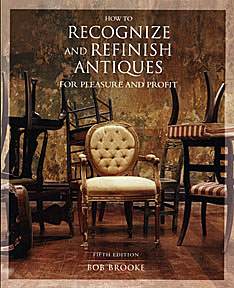
Have
you ever bought an antique or collectible that was less than perfect and
needed some TLC? Bob's new book offers tips and step-by- step
instructions for simple maintenance and restoration of common antiques.
Read an
Excerpt
|
|

|
|
|
|
|
